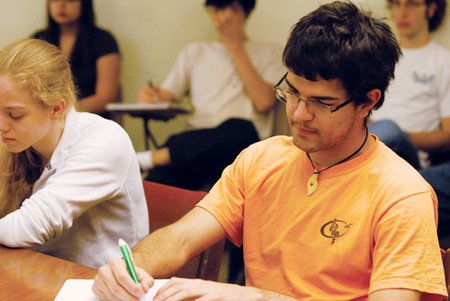Anyone who was ever an undergraduate probably remembers sitting through a "breadth requirement" course in a subject outside their major. Perhaps it was called "Physics for Poets" or "Classics for Chemists," but behind the cheerful nickname often lay an experience that was grueling, baffling, or merely dull: a forced march through unfamiliar terrain, all in the name of a well-rounded education.
Caltech undergrads all take the same core curriculum—which includes five courses each of physics and math, among other daunting requirements—no matter what field they'll later specialize in. But thanks to the Innovation in Education Fund, lively new alternatives to traditional introductory classes are being added to the course offerings, and advanced courses with up-to-the-moment topics are being designed as well.
The biggest changes so far have been to the core lab courses in biology and chemistry. One notable example is Chemistry 3x, which a small group of students beta-tested last academic year. The new course teaches basic lab chemistry through an integrated set of experiments that attack a single problem using techniques and ideas from many areas of chemistry. The inaugural problem was solar energy conversion, a current research focus not only for Caltech chemists, but for biologists, physicists, materials scientists, engineers, and others.
The required freshman biology course has a new version, too, Bi 1x. While retaining the traditional mission of introducing students to biological concepts and laboratory methods, Bi 1x aims to "explore the great ideas of biology" experimentally, using a combination of molecular biology techniques and advanced microscopy. Even Physics 1 and 2, lecture courses all freshmen take, have been spruced up with new demonstrations that, according to Vice Provost Melany Hunt, are "pretty cool."
The Innovation in Education Fund is also underwriting new advanced courses for undergrads. One course gives students the chance to design and construct biodevices, such as pulse-rate monitors or milk-freshness analyzers. Another new class, the year-long "Aerospace Engineering," shows students what's behind a successful space mission, from the fundamentals of rocket propulsion to mission cost and life-cycle analysis. In a third new course, Anthropology 142, students will help design a subsequent course that will examine the cultural and social life of Caltech undergraduates themselves.
The Innovation in Education Fund was made possible by the Caltech Associates. Founded in 1926 by 100 of Pasadena's most prominent citizens, the Caltech Associates supports a variety of Institute programs and initiatives and offers members such "insider" perks as Athenaeum membership and the chance to travel with faculty. One of the organization's recent projects has been raising money for the Innovation in Education Fund, which aims to underwrite a new course, piece of equipment, or other teaching enhancement for undergraduates each year. The estate of the late Caltech engineering professor George Housner became aware of the project, and offered to contribute an additional $500,000 to the fund if the Associates could raise $1 million by July 2010. Thanks to a lead gift from alumnus Ted Johnson ('56) and contributions from 24 other donors, the Associates met that goal before the deadline—which is exciting news for Caltech students.
With the Innovation in Education Fund successfully up and running, the Associates will now return to their core mission: raising unrestricted funds for all of Caltech.




